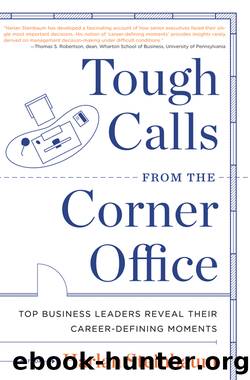Tough Calls from the Corner Office by Harlan Steinbaum

Author:Harlan Steinbaum
Language: eng
Format: epub
Publisher: HarperCollins
Published: 2011-02-01T00:00:00+00:00
DAVID FARRELL
President, Chairman, and CEO, May Department Stores Company
When David Farrell became chairman and CEO of May Department Stores in 1979, the company and industry were at a crossroads. New competitors and shifting trends were challenging the old business models; shopping centers were saturating the marketplace; families were moving to the suburbs (many of Mayâs stores were in old downtown locations); and specialty retailers as well as discount stores were popping up and growing at a rapid pace. May was not keeping up with the new selling environment, and its numbers reflected it.
Farrell had another big problem. May had grown mainly by acquisition as the company purchased many family-owned department stores around the country over the years. Management control of this growing, disparate entity had not kept pace. For the most part, the families continued to run these businesses, and they ran them all differently and sometimes not very well. Many were weak in all vital areas: products, merchandising, presentation, operations, control. Because it remained so decentralized, Mayâs management was unable to bring any kind of unified vision or strong direction to this collection of stores.
When Farrell took over, he instinctively knew this had to change, and that meant transforming the company from a collection of quasi-independent operations to a united company committed to a culture of excellence, high expectations, and high performance. His vehicle for accomplishing this was a plan called âthe May Mission.â
Farrellâs defining moment came with the development and adoption of the May Mission. He turned to some of the best minds in management, the prestigious global consulting firm of McKinsey & Company, to help him develop the mission and plan for its rollout.
Consultants can provide sound and even brilliant advice. But when theyâre done with the project and the report is written, they move on to the next client. Often they are not there when the client begins to implement the plan, nor are they around for the aftermath, which is not always pretty. By using consultants, Farrell chose a direct but potentially risky path. He introduced a plan created âfrom aboveâ by consultants and a small group of senior management and then asked everyone to support and implement a plan they did not participate in creating and had not been asked to approve. He knew heâd be swimming upstream, but his instincts told him that this was the only way to make a radical and necessary change in the way the company was run.
In total, Farrell was with May for forty-six years. When he started, volume was between $300 million and $400 million; when he retired, it was $14 billion. May was sold to Federated Department Stores in 2005 for $11 billion.
The May Company essentially grew through acquisitions. There was internal growth as well, but over the years we acquired a number of department stores, starting in Cleveland. They were established stores, and in many cases family-owned stores. Often, after May acquired them, a member of the owning family would become a director of the May Company.
Download
This site does not store any files on its server. We only index and link to content provided by other sites. Please contact the content providers to delete copyright contents if any and email us, we'll remove relevant links or contents immediately.
| Biographies | Company Profiles |
| Economic History |
Pale Blue Dot by Carl Sagan(4960)
The Rules Do Not Apply by Ariel Levy(4912)
Goodbye Paradise(3764)
Ogilvy on Advertising by David Ogilvy(3555)
Liar's Poker by Michael Lewis(3416)
Delivering Happiness by Tony Hsieh(3397)
Into Thin Air by Jon Krakauer(3349)
Purple Cow by Seth Godin(3168)
Rogue Trader by Leeson Nick(3011)
The Social Psychology of Inequality by Unknown(2990)
The Airbnb Story by Leigh Gallagher(2822)
4 - Harry Potter and the Goblet of Fire by J.K. Rowling(2686)
The Mind Map Book by Tony Buzan(2547)
Bossypants by Tina Fey(2501)
Claridge's: The Cookbook by Nail Martyn & Erickson Meredith(2384)
All the President's Men by Carl Bernstein & Bob Woodward(2347)
Six Billion Shoppers by Porter Erisman(2282)
Master of the Game by Sidney Sheldon(2266)
Alibaba by Duncan Clark(2060)
